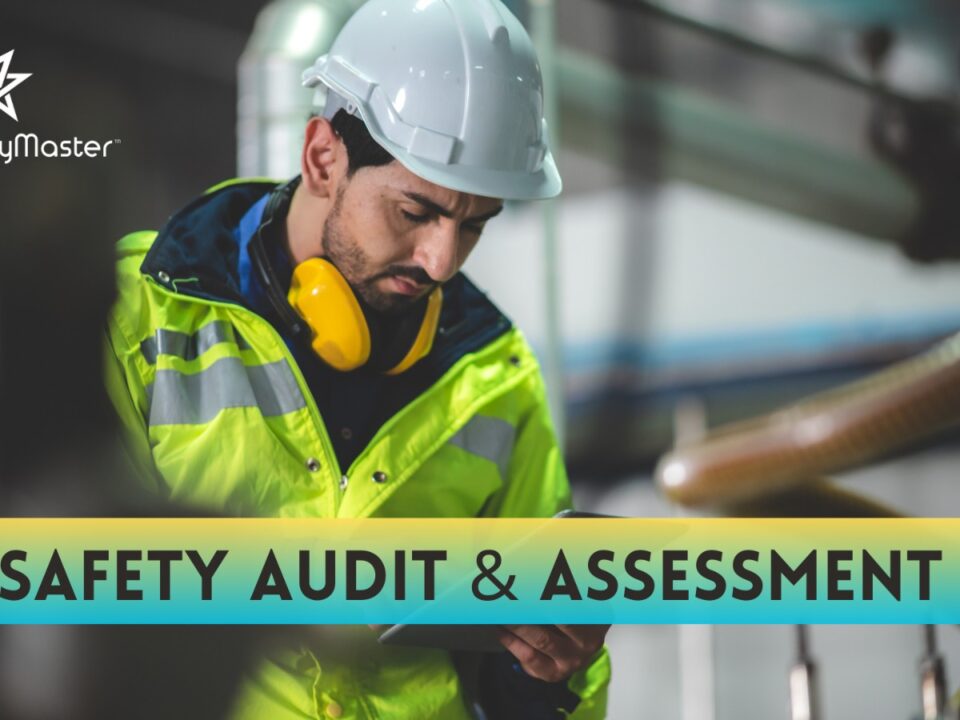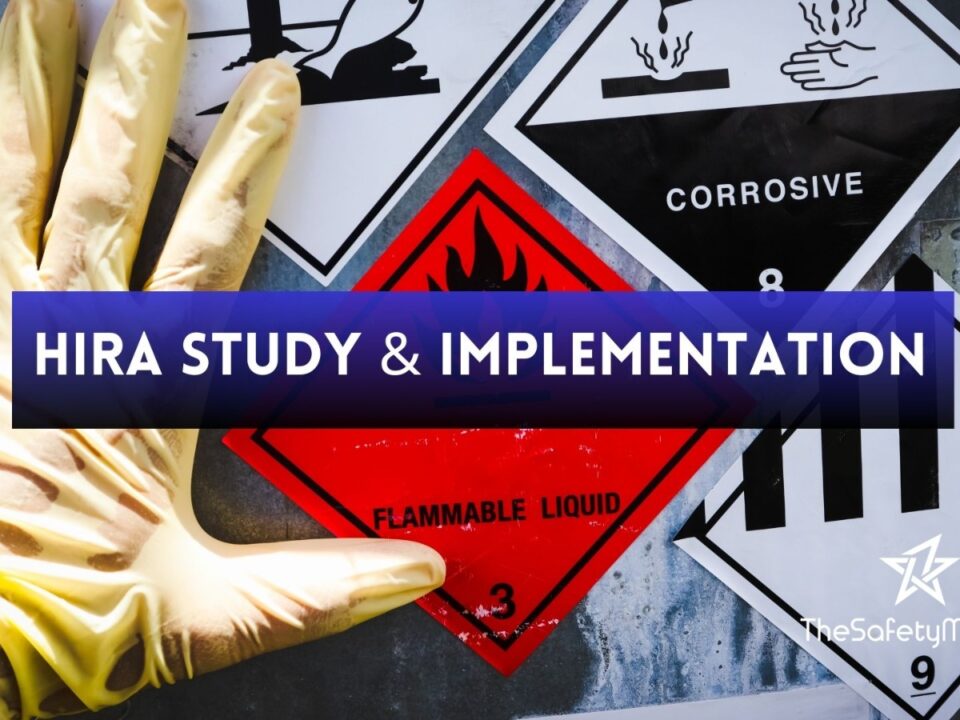Job Safety Analysis Study Report and Training by TheSafetyMaster

Safety Software Solution, TSM-Digitech by TSM TheSafetyMaster P Limited
September 27, 2023
Integrated Management System Internal Auditor Training by TheSafetyMaster
September 28, 2023In today’s fast-paced and ever-evolving world, workplace safety has emerged as a paramount concern for organizations across industries. Understanding the significance of maintaining a safe working environment, TheSafetyMaster presents its comprehensive Job Safety Analysis Study Report and Training. This cutting-edge program aims to equip organizations with the knowledge and tools necessary to identify potential hazards, assess risks, and implement effective controls to create a secure work environment.
The Job Safety Analysis (JSA) methodology provided by TheSafetyMaster serves as an indispensable guide for businesses aiming to proactively manage occupational risks. By breaking down complex tasks into individual steps, organizations can meticulously analyze each aspect of the job to identify potential hazards. Through this meticulous process, employees gain a deeper understanding of their roles and responsibilities in maintaining overall workplace safety.
Ensuring the safety and well-being of employees in the workplace is a top priority for any responsible organization. However, with ever-evolving work environments and potential hazards lurking around every corner, maintaining a safe working environment can be a complex challenge. This is where the concept of Job Safety Analysis (JSA) comes into play.
In this comprehensive article, we will delve into the world of Job Safety Analysis Study Report and Training by TheSafetyMaster, a leading authority in workplace safety. We will explore the importance of conducting a JSA, understand its fundamentals, and provide you with a step-by-step guide on how to perform one effectively. By the end of this article, you can expect to gain valuable insights into improving workplace safety and empowering your workforce.
Understanding the Basics: What is a Job Safety Analysis (JSA)?
A Job Safety Analysis (JSA) is a systematic process that aims to identify and evaluate potential hazards in the workplace. It involves breaking down job tasks into individual steps, analyzing each step for potential risks, and implementing effective controls to minimize or eliminate those risks. In simple terms, a JSA provides a structured approach to assess safety concerns associated with specific jobs or work activities.
By conducting a JSA, organizations can proactively identify hazards before they cause accidents or injuries. This analysis helps employers understand the sequence of steps involved in a particular job and determine which tasks pose potential risks to workers’ health and safety. Furthermore, it enables employers to develop preventive measures and implement controls that ensure employees can perform their duties safely and confidently.
The Benefits of Conducting a JSA for Workplace Safety
A Job Safety Analysis (JSA) is a valuable tool that brings numerous benefits to workplace safety. By conducting a JSA, organizations can proactively identify potential hazards, assess risks, and implement effective controls to ensure the well-being of their employees. One key benefit of JSA is the reduction in workplace accidents and injuries. By analyzing job tasks step-by-step, organizations gain a comprehensive understanding of potential risks and can take preventive measures accordingly. This not only safeguards the physical health and safety of employees but also contributes to improved productivity by minimizing work disruptions caused by accidents or injuries.
Moreover, conducting a JSA fosters a culture of awareness and accountability in the workplace. Employees become more conscious of their surroundings and are encouraged to report potential hazards or suggest safer practices. This collaborative approach promotes teamwork and empowers every individual to actively participate in maintaining a safe work environment. Additionally, when organizations prioritize employee safety through JSA initiatives, it enhances employee morale and satisfaction, leading to increased loyalty, productivity, and overall job satisfaction.
Step-by-Step Guide: How to Perform a Job Safety Analysis
Performing a Job Safety Analysis (JSA) is an essential process for ensuring workplace safety. By systematically breaking down job tasks and identifying potential hazards, organizations can create a safer working environment. Here is a comprehensive step-by-step guide on how to conduct an effective JSA:
Step 1: Select the Job Task
Choose a specific job task that you want to analyze. This could be any task within your organization, ranging from operating heavy machinery to handling hazardous substances.
Step 2: Break Down the Task into Steps
Divide the selected job task into smaller steps or actions. Be as detailed as possible, ensuring that each step is clear and distinct.
Step 3: Identify Potential Hazards
Analyze each step of the job task and identify potential hazards associated with it. These hazards can include physical risks, environmental factors, or even ergonomic issues.
Step 4: Assess Risk Severity and Likelihood
Evaluate the severity and likelihood of each identified hazard. Consider the potential consequences if an accident were to occur as well as how likely it is for the hazard to manifest.
Step 5: Implement Control Measures
Create measures that minimize or eliminate the identified hazards. This may involve implementing engineering controls, providing personal protective equipment (PPE), or establishing safe work procedures.
Step 6: Communicate and Train Employees
Identifying Hazards in the Workplace: A Comprehensive Approach
In order to ensure a safe and secure working environment, it is crucial to adopt a comprehensive approach when identifying hazards in the workplace. The process of hazard identification involves carefully analyzing every aspect of the work environment to identify potential risks that may cause harm or injury to employees. This proactive approach allows organizations to take necessary measures and implement effective controls to minimize or eliminate these hazards altogether.
When conducting a comprehensive hazard identification, various factors must be taken into consideration. These include evaluating the physical layout of the workspace, examining equipment and machinery for any potential dangers, reviewing work procedures and practices, as well as considering environmental factors that may pose a risk. It is essential not to overlook any aspect that could potentially contribute to workplace accidents or injuries.
The process begins by conducting thorough observations and inspections across all areas of operations. This ensures that no potential hazard remains unnoticed. Additionally, engaging employees in this process can be incredibly valuable as they possess firsthand knowledge about their work tasks and can provide valuable insights regarding potential risks they encounter daily.
Breaking Down Job Tasks: Analyzing Each Step for Potential Risks
When it comes to ensuring a safe and secure work environment, nothing is more crucial than thoroughly breaking down job tasks and analyzing each step for potential risks. By meticulously examining the intricacies of every task, we empower ourselves to proactively identify hazards and implement effective controls that can mitigate or eliminate risks.
Imagine a world where every single process in the workplace is dissected with precision, allowing us to anticipate dangers before they manifest. This level of scrutiny not only safeguards our employees but also promotes efficiency and productivity. By scrutinizing job tasks, we unlock a wealth of knowledge about potential pitfalls that may have previously gone unnoticed. This comprehensive approach ensures that no stone is left unturned, enabling us to create an environment where safety reigns supreme.
Prioritizing Hazards: Assessing the Severity and Likelihood
Once the hazards in the workplace have been identified through a thorough job analysis, it is crucial to assess their severity and likelihood. This step allows organizations to prioritize the risks and allocate resources effectively for implementing control measures. By evaluating both severity and likelihood, TheSafetyMaster ensures a comprehensive approach to enhancing workplace safety.
When assessing the severity of a hazard, we consider the potential consequences it may have on workers’ health and safety. TheSafetyMaster employs a multi-tiered approach that takes into account not only physical harm but also psychological well-being. By doing so, we ensure that all aspects of worker safety are addressed, creating an environment where employees can thrive without compromising their mental or physical health.
Implementing Effective Controls: Minimizing and Eliminating Risks
Once the hazards have been identified through a thorough Job Safety Analysis (JSA), the next crucial step is to implement effective controls that will minimize and eliminate the risks present in the workplace. The goal is to create a safe environment for all employees, where potential accidents and injuries are reduced to an absolute minimum.
To successfully implement controls, it is essential to consider a combination of engineering, administrative, and personal protective equipment (PPE) measures. Engineering controls involve modifying the physical environment or processes in order to eliminate or reduce hazards. This could include installing machine guarding, implementing ventilation systems, or redesigning workstations.
Administrative controls focus on changing work practices and policies to reduce exposure to hazards. This may involve implementing standard operating procedures (SOPs), training employees on safe work practices, scheduling regular maintenance checks, or establishing emergency response protocols. By fostering a culture of safety awareness and responsibility among workers, administrative controls can greatly contribute to risk reduction.
Training and Communication: Ensuring Employee Buy-In and Compliance
When it comes to job safety, training and effective communication are paramount. It is not enough to simply identify potential hazards and implement control measures; you must ensure that all employees are on board and committed to following the prescribed safety protocols. By fostering a culture of constant learning, engagement, and open communication, your organization can truly empower its workforce to prioritize safety in every task they undertake.
Training programs should be comprehensive, tailored to specific job roles, and delivered in an engaging manner. Utilize various training methods such as classroom sessions, hands-on demonstrations, interactive workshops, and e-learning modules to accommodate different learning styles. Reinforce the importance of safety by incorporating real-life examples of accidents or near misses that highlight the consequences of disregarding safety procedures.
Continuous Improvement: Monitoring and Reviewing Your JSA
Once you have implemented your Job Safety Analysis (JSA) and put controls in place to mitigate risks, the journey towards a safer workplace does not end there. Continuous improvement is essential to ensure ongoing effectiveness and adaptability. Monitoring and reviewing your JSA is crucial in identifying areas for enhancement and addressing any unforeseen hazards that may arise.
The process of monitoring your JSA involves regular assessments and observations of the job tasks being performed. By actively engaging with employees, supervisors can gather valuable insights into the practical application of safety measures. This enables them to evaluate if the implemented controls are functioning as intended or if adjustments are needed.
Moreover, reviewing your JSA allows for a comprehensive analysis of data collected over time. By examining incident reports, near misses, and even employee feedback, you can identify patterns or trends that may require additional attention. This proactive approach empowers organizations to make informed decisions that prioritize hazard prevention and ensures adjustments are made promptly.
In summary, continuous improvement through monitoring and reviewing your JSA not only fosters a culture of safety but also demonstrates a commitment to employee well-being. By staying vigilant, proactive, and responsive to potential risks in the workplace, organizations can create an environment where everyone feels empowered to contribute their best while maintaining utmost safety.
Real-Life Examples: Success Stories of Job Safety Analysis
Incorporating job safety analysis (JSA) into your workplace can have remarkable effects on safety outcomes. Let’s explore a few success stories that highlight how organizations have embraced JSA and reaped its benefits.
One notable example is a manufacturing company that saw a significant reduction in workplace incidents after implementing JSA. By involving employees in the analysis process, they were able to identify potential hazards and develop effective controls. This proactive approach not only improved safety but also boosted morale and productivity among workers. With each successful JSA, employees felt more empowered and engaged, knowing that their contributions played an integral role in maintaining a safe work environment.
Conclusion: Empowering Your Workplace with Job Safety Analysis
In conclusion, implementing a comprehensive Job Safety Analysis (JSA) program is not only crucial for maintaining a safe and healthy work environment, but it also leads to increased productivity and employee satisfaction. By systematically identifying and mitigating potential hazards, organizations can prevent accidents and injuries, ensuring the well-being of their workforce.
Furthermore, the JSA process promotes a culture of safety within an organization. When employees are actively involved in analyzing job tasks and suggesting control measures, they feel empowered and valued. This sense of ownership fosters a positive work environment where everyone is committed to maintaining safety standards.
Remember, workplace safety should never be compromised. By investing in thorough JSA training and regularly reviewing and updating your analysis, you are taking proactive steps towards minimizing risks and protecting your most important asset – your employees.
So let us embrace the power of Job Safety Analysis as a tool for continuous improvement in workplace safety. With every step we take towards identifying hazards,



